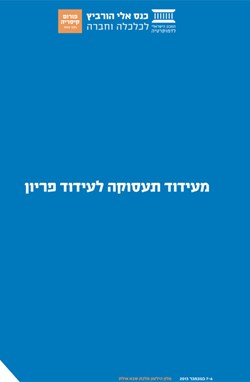From Encouraging Employment to Boosting Productivity
A Publication of the 2013 Eli Hurvitz Conference on Economy and Society
- Publication Date:
- Center: Eli Hurvitz Conference on Economy and Society

On November 6–7, 2013, IDI will convene the second Eli Hurvitz Conference on Economy and Society. Formerly known as the Caesarea Economic Policy Planning Forum, the conference fosters open discussion between senior government decision-makers and leading figures in academia, the non-profit sector, and the business world. The event will be broadcast live on the IDI website in both Hebrew and English.
Entitled From Encouraging Employment to Boosting Productivity, this Hebrew booklet was prepared in advance of the conference by a working group of researchers who explored the subject of macroeconomics. An English abstract can be found below.
According to demographic projections by the Central Bureau of Statistics, the proportion of Arabs and Haredim (ultra-Orthodox Jews) in the population will increase from 30% in 2009 to 50% in 2059. The two populations are characterized by a low level of participation in the labor market, a low number of hours per employee, and low productivity. The demographic changes imply a substantial structural change in the Israeli economy in light of the lower participation patterns of these sectors in employment and education. The numbers cited above mean that the growth rate of the non-Haredi Jewish population of prime working age is expected to drop from 1.8% per year during the past decade to 0.4% during the next two decades. Starting in 2003, the government implemented a series of measures based on the approach known as “from welfare to work,” combining cutbacks in child allowances and increased support for daycare facilities.
Subsequently, in 2008, a program of supplemental income grants was implemented for low-wage workers (“earned income tax credit”). Since then, the employment rates of Arabs and Haredim have risen significantly more than that of non-Haredi Jews. However, the former are typically employed in fields characterized by relatively low wages and a dearth of human capital. Thus, the massive entry of Arabs and Haredim into the labor market was accompanied by a widening of wage disparities: The average real wage of Haredi men even declined during the years 2004–2011. This picture reinforces the recognition that while entering the workforce is indeed an essential condition for improving the situation of these groups (relative to a situation of dependency on transfer payments), it is not a sufficient condition for ensuring ongoing improvement in productivity.
The team reached the conclusion that despite the success in boosting employment figures, the stage of integrating Arabs and Haredim in low-wage jobs did not enable these sectors to catch up to the rest of the population and thus should be seen as an intermediate stage. The team emphasized the need to move on to a more advanced stage based on integrating these groups in fields that offer higher added value, characterized by higher human capital and wages, such as the branches of technology.
With this goal in mind, a new program is recommended for the Arab and Haredi sectors—“from employment to productivity.” The new program requires a change of perspective in the utilization of policy tools: The emphasis should be on increasing productivity. A salient factor underlying this program is the low participation in higher education among the Haredim and Arabs relative to the non-Haredi Jewish population. In fact, the disparities in education are even more extreme than in the field of employment. Non-Haredi Jews receive matriculation certificates at much higher rates than the other two populations; and in regard to academic degrees, the ratio is 4 to 1 vis-à-vis Haredim and 3.2 to 1 vis-à-vis Arabs.
The proposed program includes, among others, the following measures:
- Require study of core subjects in Haredi education. The government recently decided to make the funding of Haredi educational institutions conditional upon teaching a core curriculum. This measure is vital for the proposed change in that it provides basic tools for the Haredi population that are essential for their integration in advanced education and for their subsequent employment in a range of economic branches, in particular, in the branches of technology. Thus, there must be verification that this decision is really enforced in full scope and in the shortest possible timeframe, while allocating the required resources for this.
- Teach the Hebrew language at a younger age in Arab society. Fluency in the Hebrew language is a basic component in the integration of Arabs in the advanced branches of the labor market. Instead of starting to teach Hebrew in the third year of elementary school (Grade 3), we recommend introducing the study of Hebrew earlier.
- Continue to strengthen the system of daycare facilities. We recommend continuing the effort to improve daycare facilities, which is now in an advanced process of implementation.
Head
- Prof. Michel Strawczynski, Professor of Economics and Public Policy, Hebrew University of Jerusalem; Head, Economics and Society Program, Van Leer Jerusalem Institute
Members
- Dr. Eyal Argov, Head of the Real-Macro Unit, Research Department, Bank of Israel
- Ms. Daphna Aviram-Nitzan, Head of Economics Research Department, Manufacturers Association of Israel
- Mr. Adi Brender, Director of Macroeconomics and Policy, Research Department, Bank of Israel
- Mr. Alon Etkin, Senior Economist and Advisor to Director of Budget Department, Ministry of Finance
- Mr. Assaf Geva, Senior Economist, Economics and Research Division, Ministry of Finance
- Ms. Israela Many, Deputy Managing Director for Economics and Taxes, Federation of Israeli Chambers of Commerce
- Ms. Ayelet Nir, Chief Economist and Strategist, Psagot Investment House
- Dr. Michael Sarel, Director of Economics and State Revenues, Ministry of Finance
- Ms. Nira Shamir, Chief Economist, Israel Discount Bank
- Research Assistant: Ms. Michal Gordon, School of Public Policy, Hebrew University of Jerusalem

